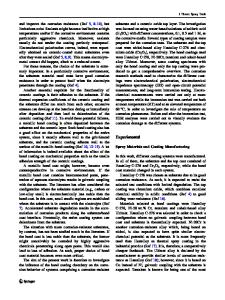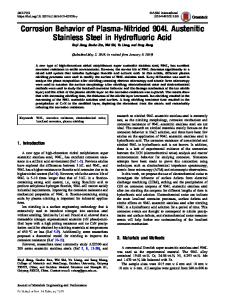Corrosion degradation behavior of PBO fibers under strong inorganic acid
- PDF / 1,869,959 Bytes
- 12 Pages / 439.37 x 666.142 pts Page_size
- 116 Downloads / 375 Views
Corrosion degradation behavior of PBO fibers under strong inorganic acid Zhaohui Jiang1,2,3,4 · Mingyue Tian1 · Zengge Guo1 · Qicai Wang1 · Zhao Jia1 · Zuowei Ding1 · Jian Jin5 Received: 18 January 2020 / Revised: 17 June 2020 / Accepted: 17 August 2020 © Springer-Verlag GmbH Germany, part of Springer Nature 2020
Abstract Known as the super fiber of the twenty-first century, poly-p-phenylenebenzobisoxazole (PBO) fibers exhibit outstanding strength and modulus, fire and heat resistance, which are superior to those of poly-p-phenylene terephthalamide fiber. However, the poor resistance of acid corrosion is regarded as a fatal weakness, which restricts its application in complicated chemical environment. In present work, PBO fibers were exposed in strong acid solutions under different conditions, and then, surface morphology was observed by optical microscopy and scanning electron microscopy. Substantial changes in functional groups were investigated by Fourier-transform infrared (FTIR) spectroscopy, as well as changes in crystalline structure using differential scanning calorimetry (DSC) and thermal stability using thermogravimetric analysis (TGA). After treatment by H 2SO4 and HNO3 solution, the strength of the fibers declines typically, while the modulus increases. It is attributed to the formation of N–H bonds in the vicinity of 3410.0 cm−1 confirmed by FTIR spectra. Hydrogen bonds, derived from N–H bonds, increase the thermal degradation temperature from 716.4 °C (untreated) to 725.6 °C (treated by H2SO4), shown in TGA 2SO4. There exist longitucurves. HNO3 treatment is more destructive than that of H dinal corrosion cracks after treatment by HNO3 solution. Furthermore, H NO3 solution penetrates into crystalline region and destroys the ordered crystal structure of PBO fibers demonstrated by DSC results. Keywords PBO fibers · Surface morphology · Chemical structure · High performance
* Zhaohui Jiang [email protected] Extended author information available on the last page of the article
13
Vol.:(0123456789)
Polymer Bulletin
Introduction Poly-p-phenylenebenzobisoxazole (PBO) fiber, providing with ultra-high strength, modulus, heat resistance and flame retardancy, is another high-performance fiber after Kevlar, carbon fiber and UHMWPE fiber. Known as the super fiber of the twenty-first century, it is an important strategic resource in the fields of national defense, military industry, aerospace and other fields. With much higher impact strength than other fibers, PBO fiber is also known as bulletproof fibers, which can be widely used in armor protection, bulletproof helmet, body armor, ballproof clothes, fire suit, space suit, lightweight structural materials and other fields [1]. PBO belongs to a new pattern heterocyclic rigid-rod polymer, consisting of oxazole ring and benzene ring. This highly conjugated rigid-rod structure determines the excellent specific strength, specific modulus, thermal stability and other excellent properties. Meanwhile, lack of active groups endows the fiber with str
Data Loading...











